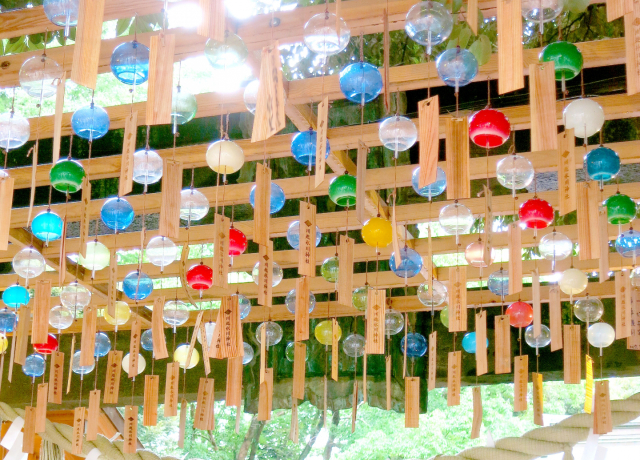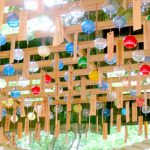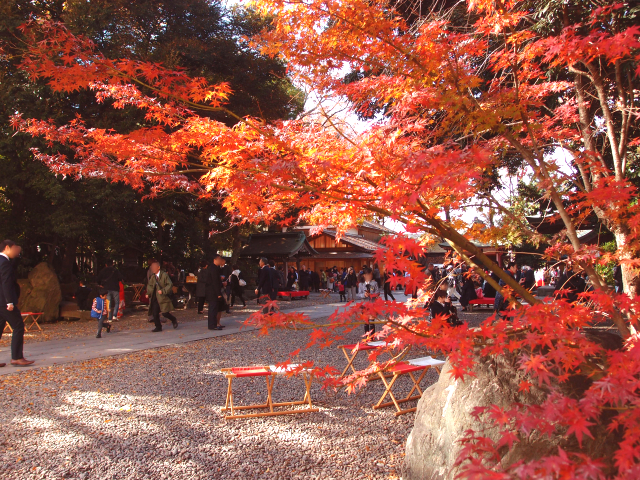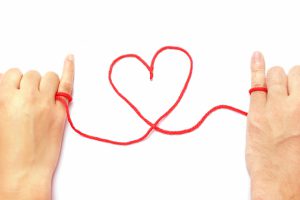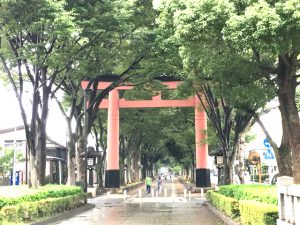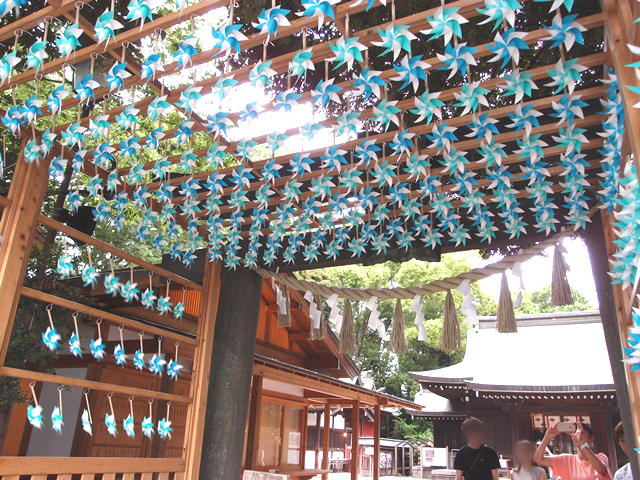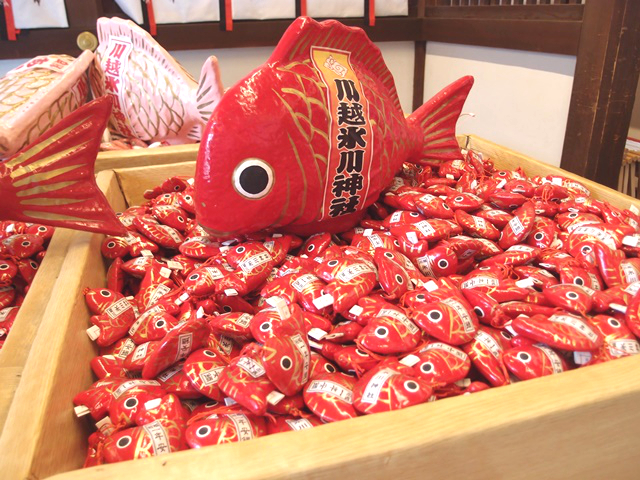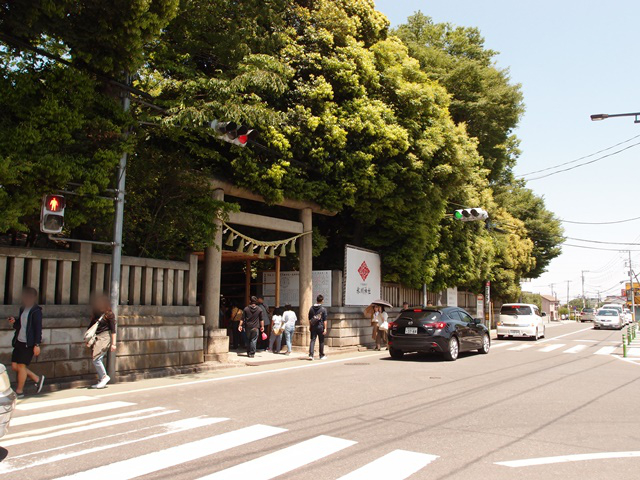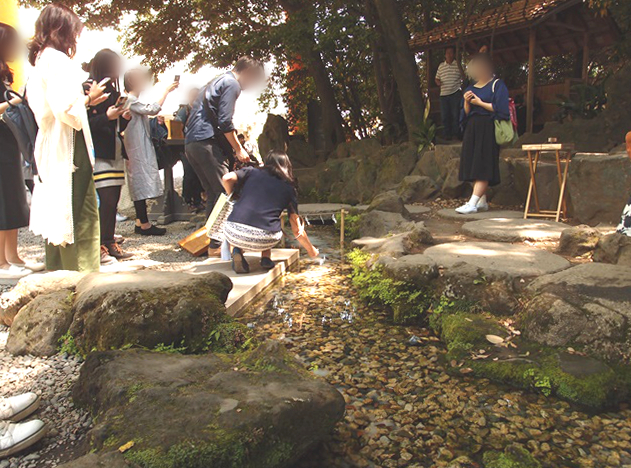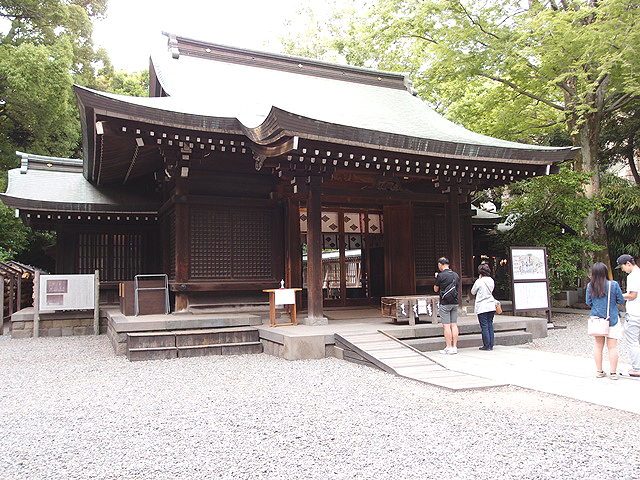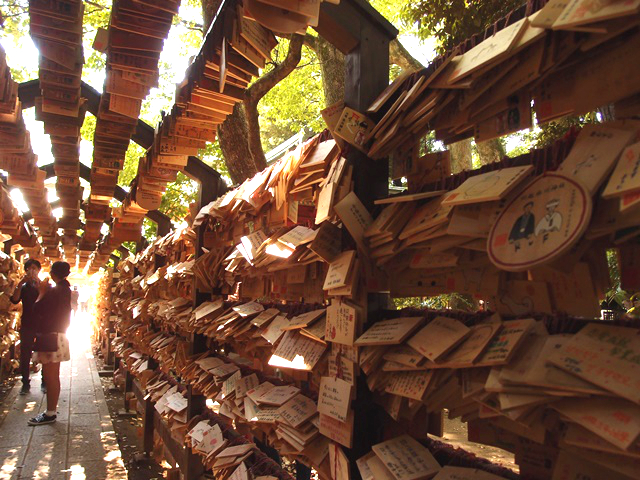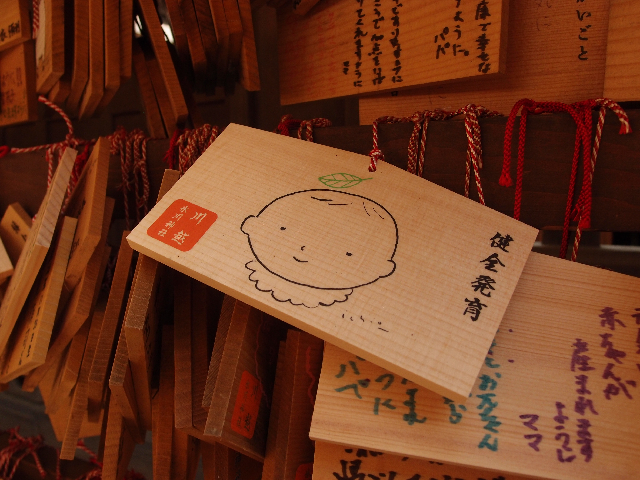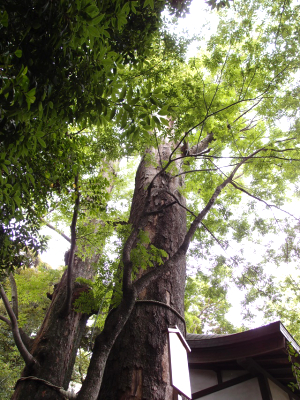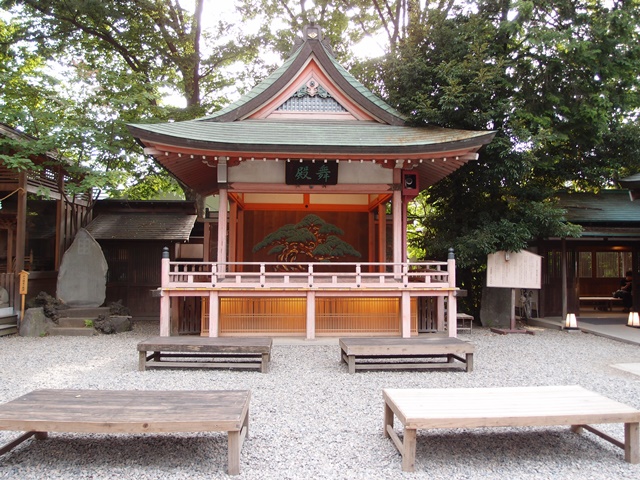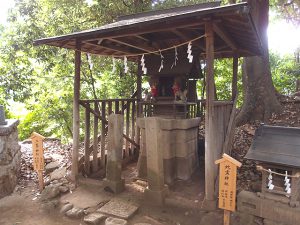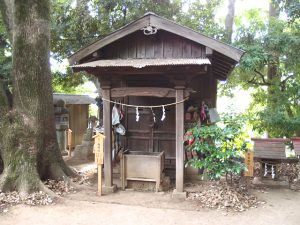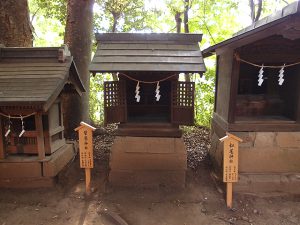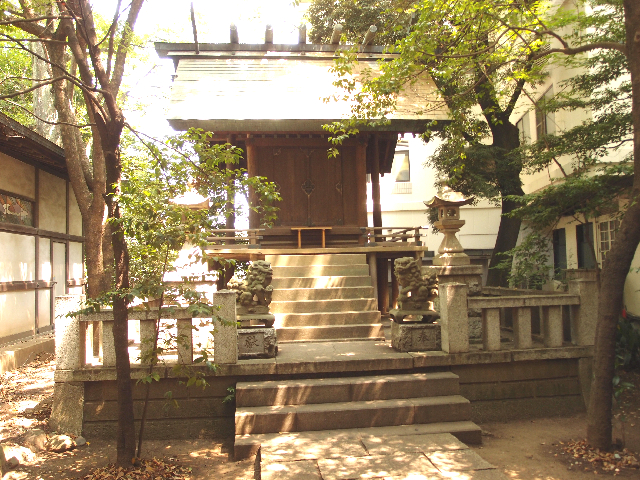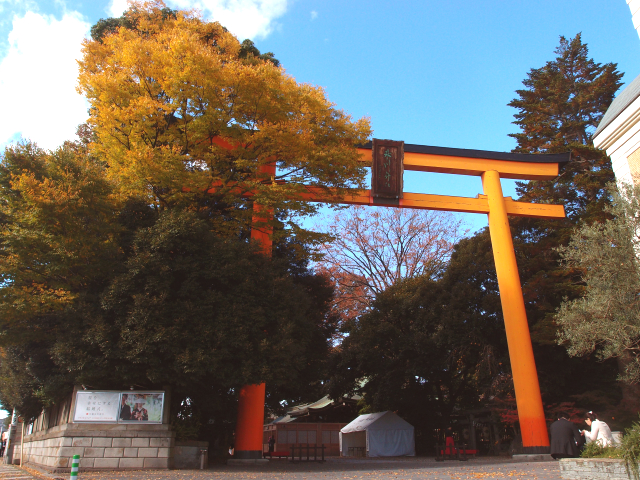The Kawagoe Hikawa-jinja shrine is located a little ways away from the main tourist street of Kawagoe. Although it is a bit difficult to get to, it is a very popular shrine in Kawagoe that is always crowded with people all year round.
Japanese
-

-
縁結びの川越氷川神社。良縁を呼び寄せる鯛みくじと風鈴の音
続きを見る
目次
- 1 About the Kawagoe Hikawa-jinja Shrine
- 2 Kawagoe Hikawa-jinja shrine’s summer tradition! Enmusubi Furin (Wind chimes of Marriage)
- 3 The Kawagoe Hikawa-jinja Shrine's Special Omamori (lucky charms) and Omikuji (fortunes)
- 4 Wedding Ceremonies at the Kawagoe Hikawa-jinja Shrine
- 5 Walking around the grounds of the Hikawa-jinja Shrine
- 6 Lunch & a Small Rest at Musubi Café
- 7 A leisurely walk behind the Kawagoe Hikawa-jinja Shrine
- 8 Access to the Kawagoe Hikawa-jinja Shrine
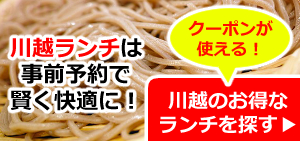
運営者一押しのランチ店リストはこちら >>
About the Kawagoe Hikawa-jinja Shrine
The Kawagoe Hikawa-jinja Shrine was founded 1500 years ago in the era of Emperor Kinmei. In the Edo era, it became the sochinju (the central place to pray to local gods) of the Kawagoe castle town, and brought forth abundant faith from the successive lords of the castle and townspeople.
The main shrine has been designated as an important cultural asset of the prefecture. It is engraved with beautiful Edo hori (engravings from the Edo period) which are used as the motif for the dolls of the Kawagoe Hikawa Festival.
The divine blessings of the enshrined deities
As two couples of married gods of a happy household are enshrined in the Kawagoe Hikawa-jinja Shrine, it is known as a shrine of marriage.
The deities enshrined here include the couple of Ashinuzuchi-no-Mikoto (no-Mikoto is an honorific suffix used for Japanese gods meaning “the grand, the great, or the exalted”) and Tenazuchi-no-Mikoto, their daughter Kushinadahime-no-Mikoto and her husband Susanoo-mo-Mikoto. Oonamuchi-no-Mikoto, the son of Kushinadahime and Susanoo is the fifth god enshrined there.
The main enshrined deity is Susanoo-no-Mikoto, whose son Oonamuchi-no-Mikoto is also known as the god of marriage at the Izumo Taisha Shrine.
The head shrine is the Omiya Hikawa-jinja Shrine
There are about 200 "Hikawa-jinja Shrines" in the Tokyo and Saitama area.
The head shrine is the "Oomiya Hikawa-jinja Shrine" in Saitama City, Saitama Prefecture.
The place name "Omiya" is derived from the honoring of the main Hikawa-jinja Shrine, “Ooinaru Miyai” (The Great Shrine).
Kawagoe Hikawa-jinja shrine’s summer tradition! Enmusubi Furin (Wind chimes of Marriage)
"Enmusubi Furin" is a popular festival that is only held from the beginning of July to the end of August. During the festival season, the shrines are decorated with more wind chimes than you can count.
Through these enmusubi furin (wind chimes of marriage) it is believed that a person’s “prayers of love will reach the Milky Way”.
If you’re aiming to take great photos, visiting during the daytime is recommended, but the light up events held at night are also magical and beautiful!
In June it is decorated with kazaguruma (pinwheels)
In June, just before the shrine is decorated with enmusubi furin, it is decorated with kazaguruma for about a month.
When the wind spins the pinwheels around and around, they are beautiful and mesmerizing to watch.
The Kawagoe Hikawa-jinja Shrine's Special Omamori (lucky charms) and Omikuji (fortunes)
The first 20 people to arrive receive a “marriage ball” lucky charm
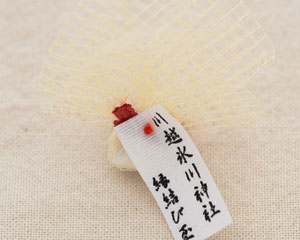

Source:Kawagoe Hikawa-jinja Shrine Official Site
Every day, the first 20 people to arrive are given a “marriage ball” lucky charm at the shrine office (free of charge).
Distribution starts at 8:00 am.
It is said that having this lucky charm will bless you with good luck in finding a partner.
If you have one and happen to meet your soul mate, then you should both visit the Kawagoe Hikawa-jinja Shrine and return the charm.
In exchange for the “marriage ball” lucky charm, you will receive a special lucky charm that will bless you with a long and steady relationship.
Omikuji (fortunes) that you that fish for- “Aitai-Mikuji” (red snapper fortunes) and “Ichinen Antaimikuji” (a year of security red snapper fortunes)
The Hikawa-jinja Shrine’s "Tai-Mikuji" (Red snapper fortunes) are quite unique.
You don’t just "pick out" the red snapper that contains your fortune. Instead, you need to "fish it out".
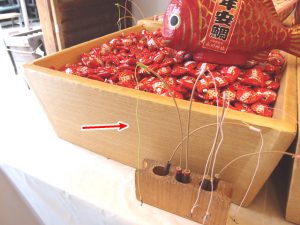

You go fishing for the Tai with a special fishing rod.
The omikuji is inside the Tai fish, so take grab it with all you’ve got.
Don’t tie your omikuji up at the shrine, please take it home with you together with the Tai (red snapper).
Always keep it with you and it will bless you with a good relationship.
Wedding Ceremonies at the Kawagoe Hikawa-jinja Shrine
The Kawagoe Hikawa-jinja shrine is also a popular wedding hall that blesses your marriage.
The music video of the classic graduation season song “Sangatsu Kokonoka (March 9th)” by Remioromen, properly depicts a wedding ceremony at the Kawagoe Hikawa-jinja Shrine.
In the video, there is a scene where the couples place a red string on the pinky finger of their left hands. This is part of the Kawagoe Hikawa-jinja Shrine's original ceremony, and is called "Yuihimo no gi”(tying the knot).
It corresponds to the "exchange of rings" that is done at common wedding ceremonies.
The yuihimo (knots) are individually handmade to match the size of the couple’s pinky fingers by a shrine maiden.
After the wedding ceremony, the ties are placed in a box made from paulownia wood and handed to the bride and groom.
Walking around the grounds of the Hikawa-jinja Shrine
The famous enmusubi furin at the entrance by the main street
This is the entrance of the Kawagoe Hikawa-jinja Shrine. (There are several entrances aside from this one)
As soon as you pass through the torii (Shinto shrine gate), you are immediately welcomed by the enmusubi furin (wind chimes) (summer only).
Be careful not to get in the way of people passing by when taking pictures!
The Chouzuba and the Shrine Office
As you pass under the wind chimes, there is a Chouzuba on the right, and a shrine office on the left.
The Chouzuba- Clean your hands and mouth here before you visit.


This is the Shrine office.
Check in at the reception office before praying for things like good compatibility, safe childbirth, and visiting the shrine.
Cleanse yourself of impurities at the “Harai no Kawa” (River of Purification)
On the grounds, there is a stream called the Harai no Kawa.
Here, you can release a doll in the shape of a person into the river to purify your mind and body.
The Main Shrine and Front Shrine of the Kawagoe Hikawa-jinja Shrine.
The front shrine is magnificent.
The main hall, an important cultural asset of the prefecture, is only open to the public for 2 hours one day a year during the Kawagoe Festival.
Because photography is not permitted, you cannot capture a photo, but the numerous fine engravings carved into the main shrine are absolutely breathless.
Please enjoy them with your eyes only.
When talking about the Hikawa-jinja Shrine, it’s got to be the “Furin Kairo” (Wind Chime Corridor)
川越氷川神社 縁むすび風鈴は、7月7日から。あとひと月です。#川越 pic.twitter.com/ZqljtMou8M
— 氷川会館 〜川越氷川神社〜 (@hikawa_kaikan) 2018年6月7日
In the summer, the Furin Kairo appears on the east side of the main shrine and front shrine.
Many people are mesmerized by the brightly colored wind chimes and their refreshing sounds.
You can take great photos here, but it is crowded on weekends, so you may not be able to take the picture you want.
I recommend visiting during the day on weekdays when it is relatively empty. (However, in August, it is crowded on weekends even during day)
The Ema Tunnel
Ema, literally translates to picture horse, and is a small wooden plaque on which Shinto and Buddhist worshippers write prayers or wishes.
The Ema Tunnel is adjacent to the west side of the main shrine and front shrine.
Seeing so many ema hanging on the both walls and on the ceilings will momentarily overwhelm you.
Not only are the prayers written on the ema for love, there are also many prayers for things like safe childbirth, health and development, and security.
The Kawagoe Hikawa-jinja Shrine Sacred Tree
Behind the main shrine is a sacred tree that is over 600 years old.


Stone steps have been built around the tree.
It is said that if you walk a figure 8 around the stone stairway, you will be blessed with good fortune.
Fukusenmaki at the Maidono on New Year’s
On the first three days of the New Year, there is a “Fukusenmaki” at the Maidono (shrine stage).
If you catch the fukusen scattered into the air by the Shinto priests before they fall to the ground you will be blessed for the whole year.
The Kawagoe Hikawa-jinja Shrine's Sessha and Massha
On the grounds of the Kawagoe Hikawa-jinja Shrine there are 22 Sessha and Massha.
Sessha and Massha are small sub-shrines (miniature versions of a shrine) located around the main shrine.
The small shrines that are closely related to the headquarters are referred to as "Sessha", and the small shrines that are affiliated with shrines outside of the shrine are called "Massha".
There are no formal rules in regard to the order of visiting these little shrines. Please visit your favorite god.
Here I will introduce three of the 22 sub-shrines.
Mitsumune-jinja Shrine
A small shrine of Chichibu's popular Mitsumune-jinja Shrine (Izanami-no-Mikoto / for protection against thieves and evil spirits).
Nenogongen-sha
A shrine that provides the blessing of strong legs.
When your legs are weak, after visiting this shrine, get a pair of footwear. Once your legs have mended, make an offering of 2 pairs.
Sugawara-jinja shrine
A shrine of Sugawara no Michizane (God of Tenjin).
It will give you a blessing for passing academic and entrance exams.
The Gokokujinja-shrine is quietly situated on the grounds
In the middle of the path to the Hikawa Assembly Hall is the Gokoku-jinja Shrine.
It is a shrine that honors 2970 citizens of Kawagoe who passed away in war.
The annual Gokoku-jinja Shrine Festival is held every year on April 12th.
“Daitorii” Japan’s largest wooden Torii gate
The torii is at the east side of Hikawa-jinja Shrine.
This torii, which is 15 m high, is the largest wooden torii gate in Japan.
The denomination was written by the Japanese statesman and naval engineer Katsu Kaishu.
Lunch & a Small Rest at Musubi Café
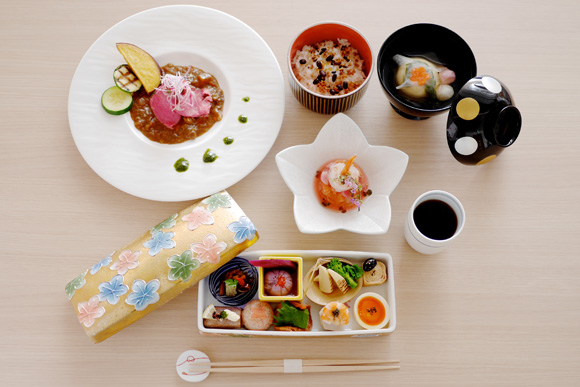

Source:Musubi Cafe Official website
Right next to the Hikawa-jinja Shrine, is a cafe restaurant called "Musubi Cafe" inside the Hikawa Kaikan building.
It is a very popular shop among women.
Because it is crowded at lunch time, we recommend that you book in advance or visit at a slightly different time.
The above photo is of the "Musubi Zen B" which is for preorder only.
It has French style cuisine, snacks (rice balls etc.), cakes, a drink menu, and so on.
A leisurely walk behind the Kawagoe Hikawa-jinja Shrine
You can go behind the shrine by making a left at the exit of the Ema Corridor.
This picture shows the Shingashigawa River in spring. It is a tributary of the Sumida River.
During this time, the roadside is full of people who come to see the cherry blossoms.
Access to the Kawagoe Hikawa-jinja Shrine
It is quite far from the station, so using the bus is recommended.
It’s not so far away that you can’t walk there….so if you like walking, it won’t be a problem.
Please be careful as the sidewalk is narrow!
From JR · Tobu Tojo Line "Kawagoe Station" or Seibu Shinjuku Line "Honkawagoe Station" ...
- From the Tobu Bus (Saitama Idai, Ageoeki Nishiguchi, Heiho, Kawagoe Undou Koeniki), get off at “Kawagoe Hikawa-jinja”. It is less than a 1 minute walk from the stop
- From the Tobu bus (Shinmeicho shako · Josai kokouiki), get off at “Kita-cho". It is a 5 minute walk from there.
- From the Eagle Bus Koedo Junkai bus, get off at “Hikawa-jinja shrine mae”. It is less than a 1 minute walk from the stop.
At Kawagoe station, the Tobu bus leaves from the east exit, and the Eagle bus leaves from the west exit.
The bus stop of Honkawagoe station is only located at the east exit.
The Kawagoe Hikawa Shrine Parking Lot
There is a dedicated parking lot at the front and rear of the Kawagoe Hikawa-jinja Shrine.


